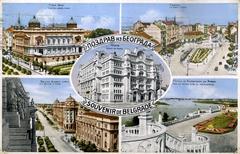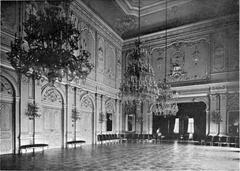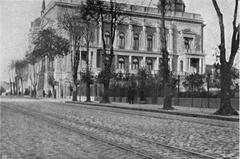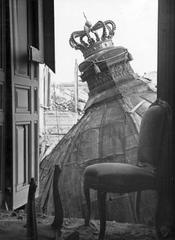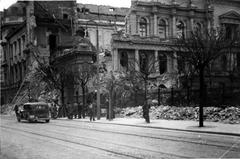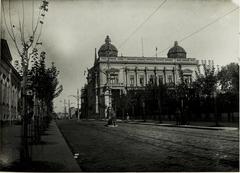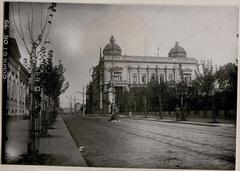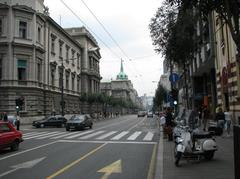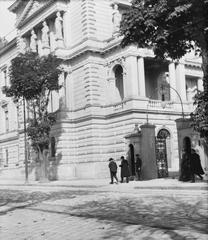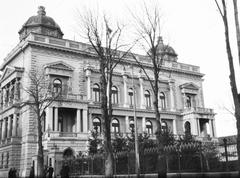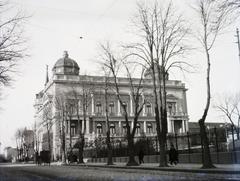
Stari Dvor (Old Palace) Belgrade: Visiting Hours, Tickets, and Complete Guide
Date: 14/06/2025
Introduction
Stari Dvor, or the Old Palace, stands at the heart of Belgrade as a monument to Serbia’s royal and political heritage. Built between 1882 and 1884 for the Obrenović dynasty, this neoclassical masterpiece reflects Serbia’s aspirations for modernization and its alignment with European culture during a pivotal chapter in the nation’s development (Balkan Kaleidoscope; dvorcisrbije.rs). Its strategic location in the Stari Grad district, adjacent to Pioneer Park and opposite Novi Dvor (New Palace), places Stari Dvor at the core of Belgrade’s urban and historical landscape.
The palace’s architectural grandeur—marked by Beaux-Arts, neo-Baroque, and neo-Renaissance influences—features imposing columns, ornamental façades, and richly decorated interiors. It has witnessed key moments in Serbian history, including the dramatic May Coup of 1903, which reshaped the nation’s royal lineage and political alliances (thecrazytourist.com; belgrademyway.com).
Today, Stari Dvor serves as the seat of the Belgrade City Assembly, balancing its historic legacy with modern civic functions. While interior access is limited and mainly available through guided tours or special events, the palace’s setting—nestled among gardens and surrounded by prominent landmarks—offers a compelling experience for visitors (Evendo; Tourist Organization of Belgrade).
This guide details Stari Dvor’s origins, architectural significance, visiting hours, ticketing information, accessibility, guided tours, and travel tips, ensuring you have all the information needed for a memorable visit to one of Belgrade’s most treasured landmarks.
Table of Contents
- Origins and Construction
- Royal Residence and Historical Events
- Architectural Style and Features
- Interior Layout and Decoration
- Political Transformations and Civic Role
- Visiting Hours, Tickets, and Accessibility
- Guided Tours and Special Events
- Nearby Attractions
- Practical Visitor Tips
- Frequently Asked Questions (FAQ)
- Visuals and Media
- Sources and Further Reading
Origins and Construction
Stari Dvor was commissioned by King Milan I of Serbia, with construction beginning in 1882 and completed in 1884. Intended as the principal royal residence for the Obrenović dynasty, the palace symbolized Serbia’s modernization and newfound prestige after becoming a kingdom (Balkan Kaleidoscope). Its neoclassical architecture—with a symmetrical façade and grand columns—aligns with 19th-century European trends and Serbia’s efforts to integrate into the Western sphere. The palace’s central location marked a new phase in Belgrade’s urban development.
Royal Residence and Historical Events
Stari Dvor served as the home to King Milan I and his son, King Alexander Obrenović. The palace became a hub for political and social gatherings, hosting royal banquets, state ceremonies, and diplomatic receptions. The May Coup of 1903, during which King Alexander and Queen Draga were assassinated, marked a turning point in Serbian history, ending the Obrenović dynasty and ushering in the Karađorđević family (Balkan Kaleidoscope). After the coup, the new dynasty continued to use Stari Dvor for official events until Novi Dvor was completed.
Architectural Style and Features
Stari Dvor exemplifies late 19th-century Serbian academism, blending neoclassical, Beaux-Arts, neo-Baroque, and neo-Renaissance elements (dvorcisrbije.rs; thecrazytourist.com). Designed by Aleksandar Bugarski, the palace has a square footprint (about 40 x 40 meters) and emphasizes symmetry and monumental presence.
The exterior features grand Corinthian and Doric columns, ornate balustrades, wrought-iron fences, and heraldic emblems, projecting sophistication and royal authority. The façade is adorned with floral motifs and symbolic reliefs, while the palace’s position facing both Pioneer Park and Novi Dvor creates a harmonious civic ensemble (belgrademyway.com; en.wikipedia.org).
Interior Layout and Decoration
The palace’s interior centers around a vast, windowed entrance hall, flanked by galleries and supported by pillars to create a sense of grandeur (dvorcisrbije.rs). Originally, a grand oak staircase—designed by Jovan Ilkić—dominated the space, though it was destroyed during World War I. Reception rooms, such as the dance and dining halls, radiate from the central axis, with decoration overseen by Bugarski and imported furnishings from Vienna.
Other highlights include a library, winter garden, and a neo-Byzantine chapel. While some original features were lost or altered during 20th-century conflict and renovations, the spaces that remain still evoke the court’s opulence (thecrazytourist.com; trek.zone).
Political Transformations and Civic Role
Following the shift from monarchy to republic after World War II, Stari Dvor was repurposed as the administrative seat of the People’s Republic of Serbia and, later, the Belgrade City Assembly (en.wikipedia.org; Evendo). The palace’s adaptive reuse exemplifies Belgrade’s ability to preserve its heritage while embracing new political realities. Today, Stari Dvor remains an active site for municipal governance and ceremonial events, as well as a protected cultural monument (dvorcisrbije.rs).
Visiting Hours, Tickets, and Accessibility
- Palace Grounds and Pioneer Park: Open daily, typically from 6:00 AM to 10:00 PM. The park is free to access and offers beautiful views of both the Old and New Palaces.
- Interior Access: The palace interior is generally not open for unscheduled public visits due to its government function. Interior access is possible during special guided tours or cultural events.
- Guided Tours and Tickets: Tours are organized periodically—often during heritage days or by arrangement with the Belgrade City Museum or Tourist Organization of Belgrade. Advance booking is required; tickets usually cost under 500 RSD (about €4).
- Accessibility: Pioneer Park and the palace exterior are wheelchair accessible. Interior accessibility is limited due to the historic structure; visitors with mobility needs should inquire in advance for arrangements.
Guided Tours and Special Events
Guided tours, when available, provide valuable insights into Stari Dvor’s history, architecture, and royal legacy. Tours may include the grand staircase, reception halls, and council chambers. Special events—such as Museum Night or European Heritage Days—offer rare opportunities to explore the palace interior. Tours are typically in Serbian, with English options available on request (TOB).
Nearby Attractions
Stari Dvor’s central location makes it easy to combine with other key sites:
- Novi Dvor (New Palace): The former royal residence, now the presidential office, stands directly opposite.
- Pioneer Park: Once royal gardens, now a popular green space.
- National Assembly: A monumental structure a short walk away.
- Terazije Square & Knez Mihailova Street: Bustling city areas with shops, cafes, and urban life.
- Kalemegdan Fortress: A major historical site within walking distance.
(belgrademyway.com; Tourist Organization of Belgrade)
Practical Visitor Tips
- Getting There: Stari Dvor is easily reached on foot from Republic Square or via public transport (tram lines 2 or 5 to Terazije, bus line 24 to Zelena Pijaca).
- Photography: Photography is permitted in the park and palace exterior; interior photography may be restricted during tours—always ask your guide.
- Facilities: Cafés, restaurants, and public restrooms are available nearby.
- Best Time to Visit: Early mornings and late afternoons offer the best light for photography and fewer crowds.
Frequently Asked Questions (FAQ)
Q: What are Stari Dvor’s visiting hours?
A: Pioneer Park and the palace exterior are open daily from 6:00 AM to 10:00 PM. The interior is accessible only during special guided tours or events.
Q: Do I need tickets to visit Stari Dvor?
A: The grounds and park are free. Guided tours of the interior require advance booking and a nominal ticket.
Q: Are guided tours available in English?
A: Yes, upon request. Confirm availability when booking.
Q: Is Stari Dvor wheelchair accessible?
A: The exterior and park are accessible; interior access is limited. Contact organizers ahead for specific arrangements.
Q: Can I take photos inside the palace?
A: Photography is typically allowed in the park and exterior. Interior photography depends on tour policies.
Visuals and Media

Alt text: Front view of Stari Dvor, the historic Old Palace in Belgrade, showcasing its Renaissance and Baroque architectural style.

Alt text: The lush green gardens of Pioneers Park surrounding Stari Dvor, offering a peaceful urban oasis in Belgrade.
Interactive map of Stari Dvor and surrounding landmarks (example link for illustration purposes)
Sources and Further Reading
- Stari Dvor Visiting Hours, Tickets, and History: Exploring Belgrade’s Old Palace, 2024, Balkan Kaleidoscope (Balkan Kaleidoscope)
- Visiting Stari Dvor: Hours, Tickets, and Historical Insights into Belgrade’s Old Palace, 2024, dvorcisrbije.rs and thecrazytourist.com (dvorcisrbije.rs; thecrazytourist.com; belgrademyway.com)
- Visiting Stari Dvor: Hours, Tickets, and Exploring Belgrade’s Historic Old Palace, 2024, Wikipedia and Evendo (en.wikipedia.org; Evendo)
- Stari Dvor (Old Palace) in Belgrade: Visiting Hours, Tickets & Historical Guide, 2024, Tourist Organization of Belgrade and MyWanderlust (Tourist Organization of Belgrade; MyWanderlust)
- Most Historic Buildings and Sites in Belgrade (Wanderlog)
- Stari Dvor on trek.zone (trek.zone)
- Belgrade Hidden Historical Sites (secretattractions.com)
Summary
Stari Dvor is a living testament to Serbia’s royal heritage, political evolution, and architectural brilliance. Its neoclassical splendor, rich history, and central location make it an essential stop for anyone exploring Belgrade. While the palace interior is primarily accessible through guided tours and special events, Pioneer Park and the palace’s exterior provide ample opportunities to appreciate its beauty and significance. Plan ahead, check for tour availability, and combine your visit with other nearby attractions for a rewarding experience in Belgrade’s historical core.
For more travel tips, historical guides, and updates, download the Audiala app, follow us on social media, and explore our related posts. Your journey into Serbia’s past begins at Stari Dvor.
